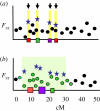Divergence hitchhiking and the spread of genomic isolation during ecological speciation-with-gene-flow
- PMID: 22201174
- PMCID: PMC3233719
- DOI: 10.1098/rstb.2011.0260
Divergence hitchhiking and the spread of genomic isolation during ecological speciation-with-gene-flow
Abstract
In allopatric populations, geographical separation simultaneously isolates the entire genome, allowing genetic divergence to accumulate virtually anywhere in the genome. In sympatric populations, however, the strong divergent selection required to overcome migration produces a genetic mosaic of divergent and non-divergent genomic regions. In some recent genome scans, each divergent genomic region has been interpreted as an independent incidence of migration/selection balance, such that the reduction of gene exchange is restricted to a few kilobases around each divergently selected gene. I propose an alternative mechanism, 'divergence hitchhiking' (DH), in which divergent selection can reduce gene exchange for several megabases around a gene under strong divergent selection. Not all genes/markers within a DH region are divergently selected, yet the entire region is protected to some degree from gene exchange, permitting genetic divergence from mechanisms other than divergent selection to accumulate secondarily. After contrasting DH and multilocus migration/selection balance (MM/SB), I outline a model in which genomic isolation at a given genomic location is jointly determined by DH and genome-wide effects of the progressive reduction in realized migration, then illustrate DH using data from several pairs of incipient species in the wild.
Figures




Similar articles
-
The genetic mosaic suggests a new role for hitchhiking in ecological speciation.Mol Ecol. 2008 Oct;17(19):4334-45. doi: 10.1111/j.1365-294X.2008.03921.x. Mol Ecol. 2008. PMID: 18986504
-
Genetic hitchhiking and the dynamic buildup of genomic divergence during speciation with gene flow.Evolution. 2013 Sep;67(9):2577-91. doi: 10.1111/evo.12055. Epub 2013 Feb 12. Evolution. 2013. PMID: 24033168
-
Genomics of divergence along a continuum of parapatric population differentiation.PLoS Genet. 2015 Feb 13;11(2):e1004966. doi: 10.1371/journal.pgen.1004966. eCollection 2015 Feb. PLoS Genet. 2015. PMID: 25679225 Free PMC article.
-
Divergent selection and heterogeneous genomic divergence.Mol Ecol. 2009 Feb;18(3):375-402. doi: 10.1111/j.1365-294X.2008.03946.x. Epub 2008 Dec 29. Mol Ecol. 2009. PMID: 19143936 Review.
-
Natural selection in action during speciation.Proc Natl Acad Sci U S A. 2009 Jun 16;106 Suppl 1(Suppl 1):9939-46. doi: 10.1073/pnas.0901397106. Epub 2009 Jun 15. Proc Natl Acad Sci U S A. 2009. PMID: 19528641 Free PMC article. Review.
Cited by
-
Antibiotic resistance shaping multi-level population biology of bacteria.Front Microbiol. 2013 Mar 6;4:15. doi: 10.3389/fmicb.2013.00015. eCollection 2013. Front Microbiol. 2013. PMID: 23508522 Free PMC article.
-
Sympatric speciation: when is it possible in bacteria?PLoS One. 2013;8(1):e53539. doi: 10.1371/journal.pone.0053539. Epub 2013 Jan 17. PLoS One. 2013. PMID: 23349716 Free PMC article.
-
Patterns, Mechanisms and Genetics of Speciation in Reptiles and Amphibians.Genes (Basel). 2019 Aug 26;10(9):646. doi: 10.3390/genes10090646. Genes (Basel). 2019. PMID: 31455040 Free PMC article. Review.
-
The uplift of the Qinghai-Tibet Plateau and glacial oscillations triggered the diversification of Tetraogallus (Galliformes, Phasianidae).Ecol Evol. 2020 Jan 22;10(3):1722-1736. doi: 10.1002/ece3.6008. eCollection 2020 Feb. Ecol Evol. 2020. PMID: 32076546 Free PMC article. Review.
-
Genomic Changes Associated with Reproductive and Migratory Ecotypes in Sockeye Salmon (Oncorhynchus nerka).Genome Biol Evol. 2017 Oct 1;9(10):2921-2939. doi: 10.1093/gbe/evx215. Genome Biol Evol. 2017. PMID: 29045601 Free PMC article.
References
-
- Rice W. R., Hostert E. E. 1993. Laboratory experiments on speciation: what have we learned in 40 years? Evolution 47, 1637–165310.2307/2410209 (doi:10.2307/2410209) - DOI - DOI - PubMed
-
- Via S. 2001. Sympatric speciation in animals: the ugly duckling grows up. Trends Ecol. Evol. 16, 381–39010.1016/S0169-5347(01)02188-7 (doi:10.1016/S0169-5347(01)02188-7) - DOI - DOI - PubMed
-
- Coyne J. A., Orr H. A. 2004. Speciation. Sunderland, MA: Sinauer Associates
-
- Felsenstein J. 1981. Skepticism toward Santa Rosalia, or why are there so few kinds of animals? Evolution 35, 124–13810.2307/2407946 (doi:10.2307/2407946) - DOI - DOI - PubMed
-
- Schluter D. 2001. Ecology and the origin of species. Trends Ecol. Evol. 16, 372–38010.1016/S0169-5347(01)02198-X (doi:10.1016/S0169-5347(01)02198-X) - DOI - DOI - PubMed
Publication types
MeSH terms
LinkOut - more resources
Full Text Sources

